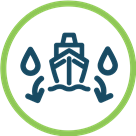
Performance indicators
Green Marine Europe requires its participants to adopt practices and technologies that have a direct impact on the environmental footprint of their operations.
Green Marine Europe environmental certification program offers a detailed framework for participants to first establish and then reduce their environmental footprint.
Our participants ship owners have to demonstrate year-over-year improvement in measurable ways to obtain their Green Marine Europe Label. The environmental program targets 11 performance indicators, addressing key environmental issues in regards to air, land and water pollution.
Performance indicators
Copyright © 2024 Green Marine Management Corporation. All rights reserved. Reproduction and distribution of the Green Marine Europe Environmental Certification Program are strictly prohibited.
- Ship owners
-
Ports and
seaway - TERMINALS
- Shipyards

AIR EMISSION - GREENHOUSE GASES

AIR EMISSIONS - NOx

AIR EMISSIONS - SOx & PM

AQUATIC INVASIVE SPECIES

COMMUNITY IMPACTS

COMMUNITY RELATIONS

OILY DISCHARGE

SHIP RECYCLING

SPILL PREVENTION AND STORMWATER MANAGEMENT

Underwater Noise

WASTE MANAGEMENT

Monitoring of regulations

Best practices

Integrated management and quantified impacts

New technologies and reduction targets

Excellence and leadership
